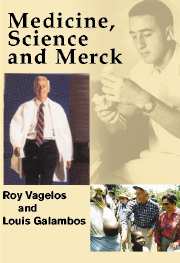Book contents
- Frontmatter
- Contents
- Preface
- 1 The Making of a Physician
- 2 Hot Science in Big Government
- 3 The French Alternative
- 4 The Research University – American Style
- 5 Turning the Corner at Merck
- 6 Crisis
- 7 Blockbusters
- 8 On-the-Job Training
- 9 Global Aspirations
- 10 The Moral Corporation
- 11 Getting to Know the Clintons
- 12 Partners
- Index
2 - Hot Science in Big Government
Published online by Cambridge University Press: 30 July 2009
- Frontmatter
- Contents
- Preface
- 1 The Making of a Physician
- 2 Hot Science in Big Government
- 3 The French Alternative
- 4 The Research University – American Style
- 5 Turning the Corner at Merck
- 6 Crisis
- 7 Blockbusters
- 8 On-the-Job Training
- 9 Global Aspirations
- 10 The Moral Corporation
- 11 Getting to Know the Clintons
- 12 Partners
- Index
Summary
One of the important factors in the improvement in human health across the globe during the last half-century was the growth of basic research at the National Institutes of Health (NIH), a large government-funded organization headquartered in Bethesda, Maryland, just outside of Washington, DC. My assignment at NIH included the care of heart disease patients – a task for which my experience at Massachusetts General Hospital had prepared me very well. But I was also going to engage in basic research, and the search for fundamental scientific knowledge was another thing entirely. I was curious but a bit uncertain about what I could accomplish. My new mentor was also uncertain.
“I've never taken on an M.D. as a postdoctoral fellow,” Earl Stadtman said during my interview at the National Heart Institute. All the scientists working with him had completed graduate training in biochemistry and, like Earl, they had Ph.D.'s. I was just a novice in biochemistry, having had only a single course in medical school. Up to this point in my career, my experiences with pure research hadn't particularly excited me. Stadtman let me know at our first meeting that he had some serious doubts about my interest in the kind of research he was doing. Nevertheless, he took the time to explain carefully and quietly the several projects under way in his laboratories at the National Heart Institute (one of NIH's eight institutes). He was so soft-spoken that I found myself leaning forward, trying to catch every word.
- Type
- Chapter
- Information
- Medicine, Science and Merck , pp. 37 - 57Publisher: Cambridge University PressPrint publication year: 2004



